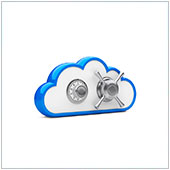 Information Security in the Cloud
Information Security in the Cloud
In the era of cloud computing, security has become a hot button issue. It seems like almost weekly there is some announcement of a system being hacked or information being leaked. In truth, this will never disappear and may only get worse unless you take steps to ensure that the cloud system you use and the files or information stored within are secure.
Here are four tips on how you can keep data stored in the cloud safe.
1. Cloud encryption is key
When you store files in the cloud, they are actually stored on a server somewhere. It would be a good idea to check with your provider what encryption they use on their servers. In case you were wondering, encryption is the conversion of data and messages into a form that can’t be easily read by unintended parties. With most digital systems, encryption will make files unreadable without the proper key to essentially decode the information and turn it into something we can read.
Checking with the different services you use can go a long way in helping you decide what to store and where. For example Google doesn’t doesn’t currently encrypt files stored on Drive. The same goes for Evernote and the free version of Dropbox. There is rumor that these companies especially Google are working on establishing encryption for all files but this may not happen for a while. Some providers like SugarSync do use encryption but it may not be enough. To ensure maximum security, look for providers that offer at least 128-bit AES encryption. Anything higher will obviously be better.
2. Secure files before they go online
All encryption can be broken and some forms just take longer. To add another level of security, it would be a good idea to encrypt or secure your files before they are uploaded to the cloud. Did you know that popular programs like Office and Adobe Acrobat allow users to encrypt documents with a password?
Another option is to add a password for access before the files are uploaded. There are other options as well, including using a program like boxcryptor that creates an encrypted folder on your hard drive and links to various cloud storage services. When you place a file into the boxcryptor folder, it will be synced with the related service and automatically encrypted.
3. Ensure files are secure when being moved
One of the weakest links of almost all cloud solutions happens when information is being uploaded or synced from your computer to the cloud. Some solutions will send information unencrypted which means hackers will be able to capture the information as it leaves or enters your network or the solution’s network.
You should make sure that the solutions you use encrypt data while it is being uploaded. In truth, almost all of the cloud services do but it would be worth it to check again.
4. Lock down your accounts
This can be a bit of a hassle but it will help keep your account and all of the important information/files stored on the cloud service secure. What do we mean by ‘lock down’? For the most part it means follow standard security protocol: Use a different password for every site and service, change passwords on a regular basis, don’t give passwords away and enable dual authentication if possible.
Services like Google Drive and DropBox offer two-factor (dual) authentication. What this means is that if you enable it, you will need to do another step before gaining access to your files. This usually means entering a code sent in a text message to your phone or answering a security question.
If you take these steps to ensure that your files and systems are secure, there should be little to no chance of having files or information stolen. We do have to warn you however that nothing is 100% secure but the more steps you take will definitely increase the security of your information. And if you’re looking for a cloud storage solution that offers the highest level of security, you can always contact us to see how we can help.







